Exclusive 2019 Update: VICTORY AT THE VA – West LA Veterans Administration master plan protects old nuclear dump from development
[According to Brentwood School, the Upper Field was “recently renovated” which may or may not have involved the removal of thallium-contaminated dirt described below.]
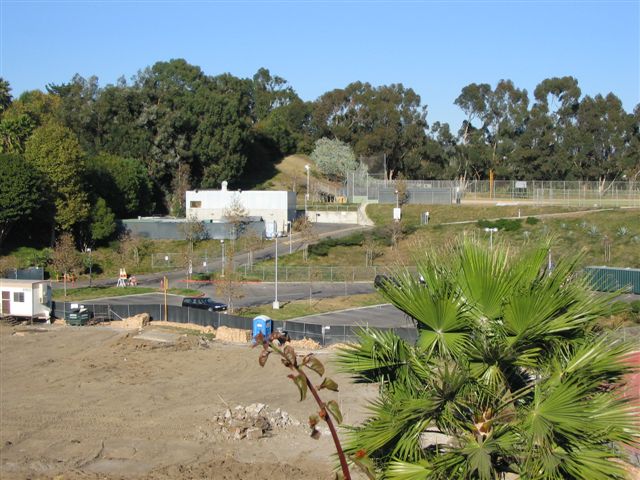
![]()
P. 9-10/172:
“Apparent medical incinerator ash was encountered during grading operations at the upper bench (Locus, 2000a). The ash was excavated and stockpiled with unacceptable fill material outside the Lease Area on GLAHS property during prior grading operations associated with construction of the athletic facilities. In order to confirm that the ash was removed from the upper bench, six soil borings were drilled at the upper bench (see Inset A, Figure 3). A single soil sample was collected from each of six soil borings at the interface between the fill and native material, which was approximately eleven feet bgs. These six soil samples were analyzed for CAM 17 Metals using EPA Method 7,000 series.” [note Inset A, Figure 3 is below on page 20]
These six borings, according to Inset A, Figure 3, were drilled nowhere near known ash pits as shown on maps yet, nevertheless, showed astonishingly high levels of the poisonous heavy metals arsenic and thallium.


P. 11-12/172:
“3.2 CAM 17 Metals Analytical Results – Six soil borings were drilled at the location where apparent medical incinderator ash was encountered during prior grading operaptions. These six soil borings were located at the direction of the GLAHS site superintendent. A soil sample was collected from each boring at the interface between native soil and fill material. These soils were analyzed for CAM 17 metals
using EPA Method 7000 series. The detected metals concentrations are reported in Table 2. All of the detected metals concentrations were less than approximately three percent of the respective Total Threshold Limit Concentrations (TTLC). TTLC are found in the California Code of Regulations, Title 22, Section 66261.24. TTLC is the threshold concentration at which point the State of California considers a waste to be hazardous, and must be handled as such. TTLCs do not apply in this situation, but provide a reference standard for comparison purposes. These detected metal concentrations are consistent with metals concentrations detected in soil samples collected by others at the Lease Area and surrounding areas in September 1999 (Appendix E). Based on the detected concentrations of metals in these six soil samples, no further action is warranted where apparent medical incinerator ash was previously encountered during grading operations.” (our emphasis)
Even though these samples not collected from a known ash pit location, they are characterized here as consistent with “metals concentrations detected in soil samples collected by others…,” which means that the entire Lease Area may be contaminated with extremely high amounts of arsenic and thallium as shown below.


P. 17/172:
The following numbers are shocking when actually compared to standards that apply to them and not TTLCs which this report correctly says “do not apply in this situation.”
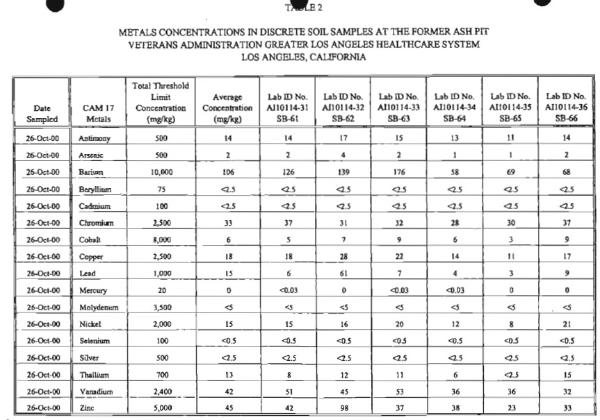
P. 20/172:
This map shows SB61-66 locations, where the sampling for the heavy metals took place, and they are in the upper bench and they are nowhere near where the mapped ash pits are.

P. 100/172:
The following table gives an even more accurate set of numbers for the CAM 17 metals.
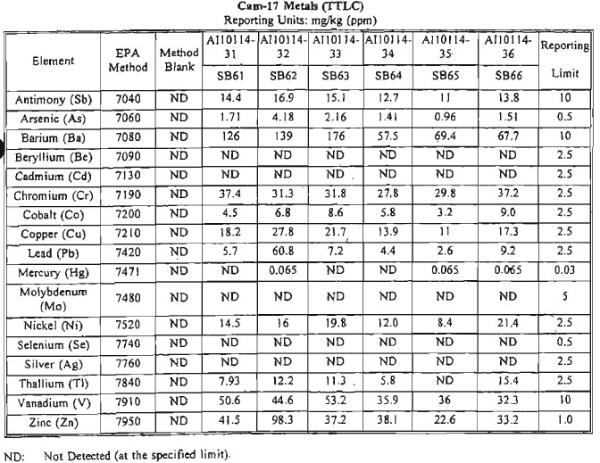
Heavy metal data analysis:
The Environmental Protection Agency has a set of standards for “Preliminary Remediation Goals,” or PRGs, which are levels to ensure no more than one cancer per million. “CAL-modified” PRGS are standards adapted to California and, in general, are more restrictive but have the same goal.
For arsenic, the CAL-Modified PRG for combined inhale/dermal/ingest of soil with arsenic = 0.062 mg/kg
Brentwood School’s (BwS) readings of arsenic = 1.99 mg/kg average which is 32.1 times 1/million residential soil standard with the highest reading, 4.18 mg/kg, 67.42 times this standard and about 4 times the state’s average for the toxic heavy metal in soil.
For thallium, BS readings = 8.77 mg/kg average; Highest 15.4 mg/kg
EPA’s chronic soil dermal-ingest combined: 5.2 mg/kg
BwS average: 1.68 x chronic
BwS highest: 2.96 x chronic
ACCORDING TO E-MEDICINE , “(T)he lethal dose of thallium is approximately 15-20 mg/kg; however, significant toxicity and death may occur with smaller amounts. Thallium poisoning more commonly occurs after oral ingestion.”
According to the Agency for Toxic Substances and Disease Registry (ATSDR) regarding thallium: an average of 1.7 ppm in soil at hazardous waste sites; 0.3 to 0.7 ppm natural average therefore:
BwS average thallium: 5.16 times average of hazardous waste sites
BwS highest thallium: 9.06 “ “ “ “ “
BwS average thallium: from 12.53 to 29.23 times natural average
BwS highest thallium: from 22.00 to 51.33 “ “ “
P. 130/172:
“SYRINGE WITH NO NEEDLE FOUND IN SOUTHERN TOUCHDOWN AREA OF FOOTBALL FIELD”
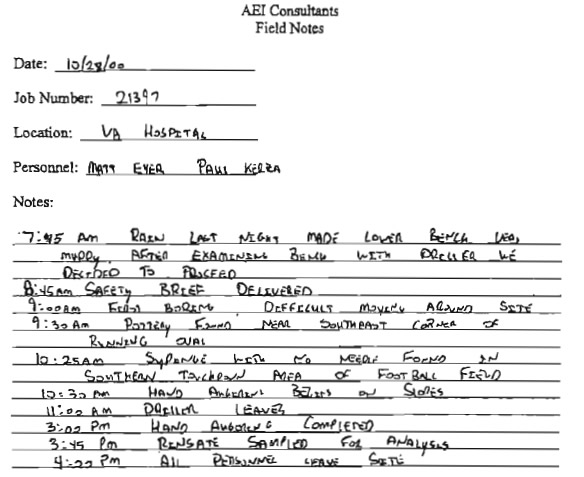
P. 130/172:
“DEBRIS – SYRINGE W/O NEEDLE… IT APPEARS THAT RAIN HAS CAUSED DEBRIS JUST BELOW SURFACE TO RISE TO SURFACE”
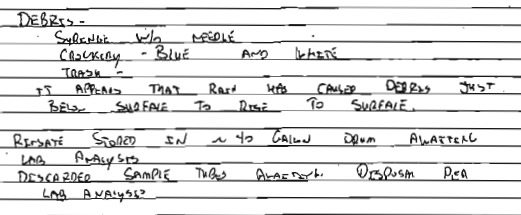
Exclusive 2019 Update: VICTORY AT THE VA – West LA Veterans Administration master plan protects old nuclear dump from development












Recent Comments